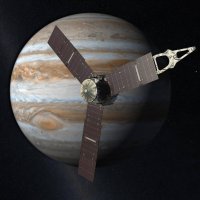In the early hours of yesterday morning Australian time, NASA’s Juno probe broke the record for humanity’s most distant solar powered spacecraft.
Juno was launched aboard an Atlas V-551 rocket from Cape Canaveral, Florida, on Aug. 5, 2011 and is now approximately 793 million kilometers from the sun.
Attached to the craft are three 9-meter solar arrays covered with 18,698 individual solar cells. NASA says the solar cells are 50 percent more efficient and radiation tolerant than silicon cells available for space missions 20 years ago.
The three arrays extend outward from Juno’s hexagonal body, giving the overall spacecraft a span of approximately 20 metres.
The huge number of solar cells are required as by the time Juno reaches Jupiter, sunlight intensity will be 25 times less than here on Earth.
“While our massive solar arrays will be generating only 500 watts when we are at Jupiter, Juno is very efficiently designed, and it will be more than enough to get the job done,” said Rick Nybakken, Juno project manager.
Around half of the output will go toward keeping the spacecraft warm and the other half will run all of the instruments and avionics.
On Earth, Juno’s solar panels would produce around 12 to 14 kilowatts of power; enough to supply all the electricity needs of a couple of households.
Juno is expected to arrive at Jupiter on July 4 and will then spend the next year orbiting the planet 33 times; getting as close as 5,000 kilometers to the gas giant’s cloud tops every 14 days.
Juno’s maximum distance from the sun will be around 832 million kilometers – almost five percent more than the previous record for solar-powered space vehicles. The previous record holder was the European Space Agency’s Rosetta spacecraft, which reached 792 million kilometres maximum distance from the sun in October 2012.
You can track Juno’s progress and read more about the mission here.
While eight other spacecraft have navigated out to as far as Jupiter (or beyond), all have used nuclear power sources.
NASA’s Voyager 1 spacecraft is the most distant man-made object in space. At the time of writing, the 38-year-old probe was around 20,108,756,846 kilometres from the Earth and 20,012,189,453 kilometres from the Sun. Voyager 1 is carrying the famous “Golden Record”, which contains 116 images and a variety of natural sounds representing humanity and life on Earth.
Solar power has played a crucial role in space exploration; often performing beyond expectations. One of the best examples is the plucky little Mars rover, Opportunity.
In 2010, Opportunity beat the Mars duration record set by NASA’s Viking 1 Lander in November 1982. Opportunity is still operating today, nearly 12 years after commencing a mission designed to last for just 3 months.
Solar power is set to continue to play an important part in Mars programs. Last year we reported engineers at NASA’s Jet Propulsion Laboratory were developing a small solar powered helicopter to act as an added set of eyes for future Mars rover missions. A rover being built for the ExoMars Programme will also be solar powered.












































